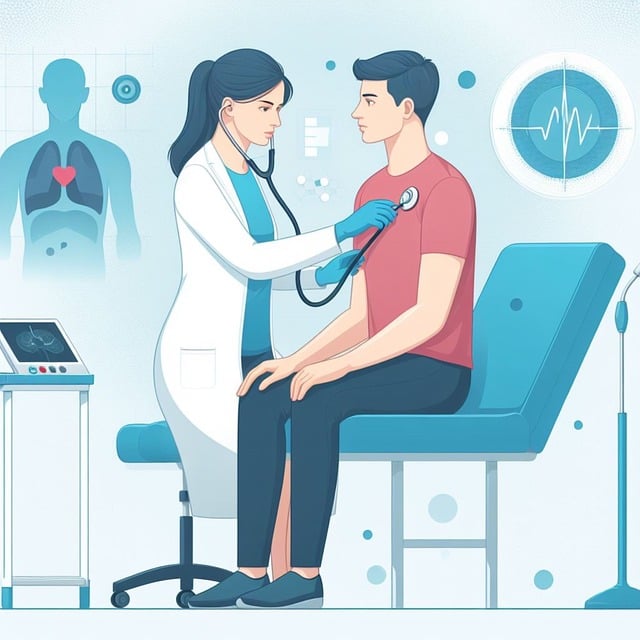In the UK's healthcare system, translation services for Patient Discharge Summaries are indispensable for ensuring non-English speaking patients fully understand their post-discharge care instructions. These translations must be precise and accurate to prevent miscommunication that could impact patient health and safety. The process involves expert medical translators who are linguistically proficient and knowledgeable in healthcare terminology, capable of navigating complex medical jargon and cultural nuances. A rigorous two-step translation process is recommended for peak accuracy, with a first translator handling the initial translation and an independent reviewer checking for both linguistic and medical term consistency. This approach leverages human expertise to deliver translations that align with the original content and uphold patient safety. Additionally, cultural competence is essential for interpreting terms and information sensitive to different cultural contexts. Despite advancements in machine translation, the intricacies of medical language require professional human translators to ensure high-quality translations of discharge summaries in the UK, thereby facilitating informed decision-making for patients transitioning from hospital care to home care.
In the intricate interplay of healthcare delivery and patient care coordination, the precision of discharge summary translations emerges as a pivotal element within the UK’s multicultural landscape. This article delves into the critical role of translation services for Patient Discharge Summaries in the UK, scrutinising the accuracy and reliability of these translations. We explore the challenges and nuances that impact translation quality, from the technical to the cultural, and compare machine versus human translations to evaluate their effectiveness. With a focus on best practices and real-world case studies, this exploration underscores the importance of linguistic accuracy in patient care continuity.
- Understanding the Importance of Precise Discharge Summary Translations in the UK Healthcare System
- The Role of Professional Translation Services for Patient Discharge Summaries in the UK
- Assessing the Accuracy of Translated Discharge Summaries: Challenges and Considerations
- Best Practices for Ensuring Linguistic Accuracy in Discharge Summary Translations
- The Impact of Cultural Nuances on Discharge Summary Translation Quality
- Evaluating the Effectiveness of Machine vs. Human Translation for Patient Discharge Summaries
- Case Studies: Real-World Examples of Discharge Summary Translations and Their Outcomes
Understanding the Importance of Precise Discharge Summary Translations in the UK Healthcare System

In the UK’s healthcare system, patient discharge summaries serve as critical documents that encapsulate a patient’s hospital stay, including diagnosis, treatment administered, and recommended post-discharge care. The accuracy of these summaries is paramount when they are translated for patients who do not speak English as their first language. Utilising professional translation services for Patient Discharge Summaries UK is essential to ensure that the information conveyed is both comprehensive and precise, facilitating a smooth transition from hospital to home. Miscommunication arising from inaccurate translations can lead to adverse patient outcomes, potentially compromising their health and safety. In an environment where healthcare is paramount, these translations are not just a matter of linguistic exchange but a cornerstone of effective post-discharge care coordination. The precision required in medical terminology demands expert translation services that specialise in the medical field, offering linguistic proficiency alongside an understanding of clinical context. This dual expertise ensures that patients and their primary caregivers receive all necessary information to manage their health post-discharge, thereby upholding the high standards of patient care that the UK healthcare system is known for.
The Role of Professional Translation Services for Patient Discharge Summaries in the UK

In the complex interplay of healthcare delivery within the UK, ensuring effective communication across linguistic barriers is paramount. Professional translation services play a pivotal role in this context, particularly when it comes to translating Patient Discharge Summaries. These summaries serve as critical documents that outline a patient’s diagnosis, treatment provided, and post-discharge care instructions, often containing sensitive information and specific medical advice. The accuracy of these translations is not just a matter of semantics; it directly impacts the quality of care a patient receives after leaving the hospital.
The UK’s diverse population necessitates that healthcare providers can communicate with patients in their preferred language. This is where translation services for Patient Discharge Summaries become indispensable. These services are staffed by professional translators who are not only proficient in multiple languages but are also trained to handle medical terminology. Their expertise ensures that the nuances of clinical language are conveyed accurately, thus allowing patients and their families to understand and follow the prescribed treatment plans. Moreover, these translations facilitate better coordination with primary care providers and other healthcare professionals involved in the patient’s ongoing care, enhancing the continuity and effectiveness of medical services across different linguistic communities within the UK.
Assessing the Accuracy of Translated Discharge Summaries: Challenges and Considerations

Assessing the accuracy of translated patient discharge summaries is a complex task that involves multifaceted challenges and critical considerations, particularly when utilizing translation services in the UK. The stakes are high, as incorrect translations can lead to misunderstandings about treatment, misdiagnosis, or even adverse outcomes for patients from non-English speaking backgrounds. To ensure a high degree of precision, translation services must employ expert medical translators who are not only fluent in the relevant languages but also well-versed in healthcare terminology and practices. These professionals must be adept at capturing the nuances of medical jargon, as well as the subtleties of cultural context that can influence patient care directives.
The accuracy of translated discharge summaries hinges on several factors. Firstly, the complexity of medical terminology necessitates a deep understanding of both the source and target languages. Translators must be able to accurately convey technical terms, pharmaceutical names, and treatment protocols without ambiguity. Additionally, they must consider the context in which these terms are used, ensuring that cultural references and idiomatic expressions are appropriately adapted or explained. Furthermore, translation services for patient discharge summaries in the UK must adhere to stringent privacy and data protection laws, such as the General Data Protection Regulation (GDPR), further complicating the process. This requires a commitment to secure handling of sensitive information throughout the translation process, reinforcing the need for reliable and trustworthy translation services to uphold patient safety and care integrity.
Best Practices for Ensuring Linguistic Accuracy in Discharge Summary Translations

When it comes to medical translations, such as those for patient discharge summaries in the UK, linguistic precision is paramount. The stakes are high due to the sensitive nature of healthcare information and the potential consequences of miscommunication. To ensure that translation services for Patient Discharge Summaries in the UK maintain the highest level of accuracy, it is essential to adhere to a set of best practices. Firstly, translators should be not only proficient in both the source and target languages but also trained specifically in medical terminology. This specialized knowledge is crucial for an accurate transfer of information from one language to another.
Secondly, employing a two-step translation process significantly enhances the quality of the discharge summaries. In this process, the first translator translates the document and then a second, independent translator reviews the work, checking for both linguistic accuracy and medical terminology correctness. This collaborative approach minimizes the risk of errors slipping through and ensures that the final translation conveys the same meaning as the original document. Additionally, utilizing advanced translation technologies can assist in maintaining consistency across terms and phrases, which is essential when dealing with medical jargon. By combining human expertise with technological tools, translation services for Patient Discharge Summaries UK can provide healthcare providers with translations that are both accurate and reliable, facilitating safe patient care across language barriers.
The Impact of Cultural Nuances on Discharge Summary Translation Quality

When it comes to patient discharge summaries, accuracy and clarity are paramount to ensure continuity of care and patient safety. Translation services for Patient Discharge Summaries in the UK must navigate the complexities of linguistic diversity while accounting for cultural nuances that can significantly impact the quality of translations. The process of converting medical documentation from one language to another is not solely about word-for-word translation; it requires a deep understanding of both the source and target languages, as well as the cultural contexts in which they are used.
Cultural nuances encompass a wide array of factors that can affect the interpretation of medical terms and information. These include social norms, idioms, and the way diseases and treatments are conceptualized within different societies. For instance, symptoms or conditions might be understood or described differently across cultures, which can lead to miscommunication if not accurately conveyed in a discharge summary translation. Similarly, certain medications or treatment protocols may have varying levels of acceptance or stigma attached to them in different cultural settings. Thus, professional translation services for Patient Discharge Summaries UK must employ experts who are not only linguistically proficient but also culturally competent, ensuring that the translations are faithful to both the original content and the cultural contexts involved. This level of expertise is crucial for maintaining the integrity of patient care as they transition from a hospital setting back to their communities.
Evaluating the Effectiveness of Machine vs. Human Translation for Patient Discharge Summaries

In the critical domain of healthcare, patient discharge summaries serve as a concise handover document that outlines a patient’s medical status upon leaving a hospital or clinic. As such, their accuracy is paramount for ensuring continuity of care and patient safety. The advent of advanced machine translation services has raised questions about their efficacy compared to human translators in producing discharge summaries for patients in the UK. While machine translation has made significant strides in recent years, offering speed and scalability, it often falls short in capturing the nuances of medical terminology and context-specific information that professional human translators excel at interpreting. Human translators bring a level of understanding that is informed by clinical knowledge and an awareness of cultural sensitivities, which can be crucial when dealing with diverse patient populations. Moreover, human translation services for Patient Discharge Summaries UK are tailored to comply with local regulations and standards, ensuring compliance with the General Medical Council’s guidelines on communication and documentation. In contrast, while machines can process large volumes of data quickly, they may misinterpret idiomatic expressions or complex clinical terms, potentially leading to misunderstandings or incorrect treatment plans for patients. Therefore, although machine translation services have their place in assisting healthcare providers, the accuracy and sensitivity required for patient discharge summaries often demand the expertise of professional human translators who can ensure that every detail is conveyed precisely and without ambiguity.
Case Studies: Real-World Examples of Discharge Summary Translations and Their Outcomes

In the realm of healthcare, patient discharge summaries serve as critical documents that encapsulate a patient’s hospital stay, providing a comprehensive overview of their treatment and care. The accuracy of these summaries is paramount when they are translated for patients who do not speak the predominant language in the region where they receive care, which is particularly relevant in multicultural societies like the UK. Translation services for Patient Discharge Summaries in the UK have become increasingly important, ensuring that patients fully understand their medical history and post-discharge care instructions. A case study involving a non-English speaking patient who underwent cardiac surgery illustrates the significance of precise translations. The discharge summary was initially translated using an automated service, which resulted in several misunderstandings regarding medication dosages and follow-up appointments. Subsequent retranslation by professional medical translation experts corrected these errors, leading to a better health outcome for the patient. This real-world example underscores the importance of utilizing skilled human translators over machine-based alternatives when dealing with discharge summaries that directly impact a patient’s wellbeing. Another case study highlights the complexities involved in translating discharge summaries for patients with rare conditions or those requiring specialized care. In one instance, a patient with a unique metabolic disorder required a discharge summary that accurately conveyed their specific dietary restrictions post-discharge. The initial translation missed critical nuances of the patient’s diet plan, which was rectified by a specialist translator with expertise in both medicine and nutrition. These case studies exemplify the need for translation services for Patient Discharge Summaries UK that are not only accurate but also tailored to the individual needs of each patient, thereby upholding the standard of care and ensuring informed decision-making as patients transition from hospital to home.
In concluding, the critical nature of precise translations for patient discharge summaries within the UK healthcare system cannot be overstated. The reliance on professional translation services to provide accurate and culturally sensitive communications is paramount to ensuring patient safety and informed decision-making. The challenges in assessing accuracy are significant, yet the stakes demand nothing less than the best practices for linguistic precision. It is evident from the case studies that while both machine and human translations have their places, the nuanced expertise of professional translation services stands out as essential for the quality of care and continuity of treatment. As such, investing in these services for Patient Discharge Summaries UK is not just a best practice—it is an imperative for healthcare providers operating in a diverse society. Ensuring that every patient, regardless of language barriers, receives clear and accurate information upon discharge is both a moral obligation and a testament to the quality of care offered by the UK’s healthcare system.



